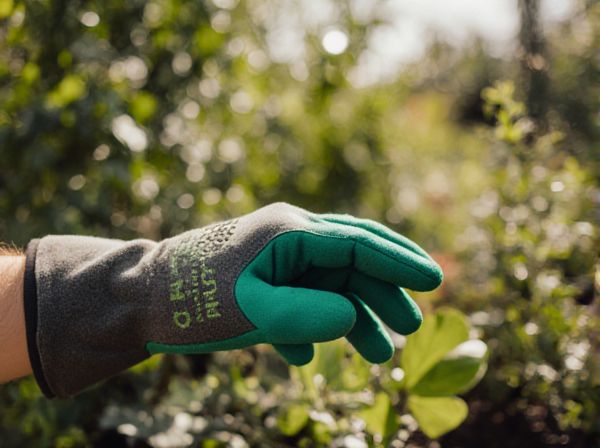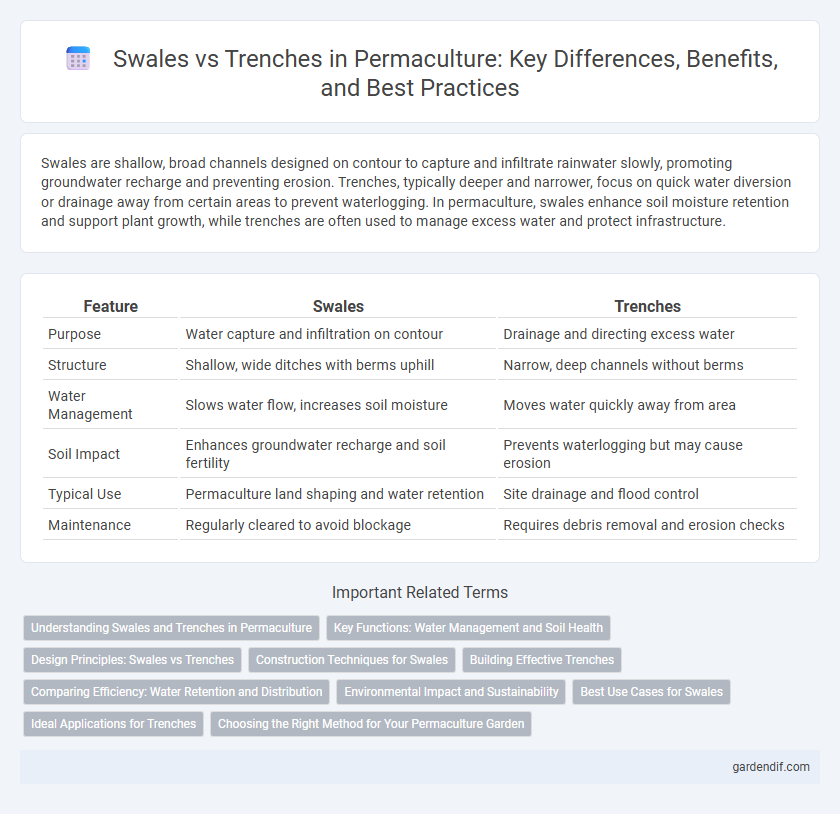
Swales vs Trenches Illustration
Swales are shallow, broad channels designed on contour to capture and infiltrate rainwater slowly, promoting groundwater recharge and preventing erosion. Trenches, typically deeper and narrower, focus on quick water diversion or drainage away from certain areas to prevent waterlogging. In permaculture, swales enhance soil moisture retention and support plant growth, while trenches are often used to manage excess water and protect infrastructure.
Table of Comparison
| Feature | Swales | Trenches |
|---|---|---|
| Purpose | Water capture and infiltration on contour | Drainage and directing excess water |
| Structure | Shallow, wide ditches with berms uphill | Narrow, deep channels without berms |
| Water Management | Slows water flow, increases soil moisture | Moves water quickly away from area |
| Soil Impact | Enhances groundwater recharge and soil fertility | Prevents waterlogging but may cause erosion |
| Typical Use | Permaculture land shaping and water retention | Site drainage and flood control |
| Maintenance | Regularly cleared to avoid blockage | Requires debris removal and erosion checks |
Understanding Swales and Trenches in Permaculture
Swales are shallow, broad channels designed on contour lines to capture and slow water runoff, enhancing soil infiltration and reducing erosion in permaculture landscapes. Trenches differ by being narrower and deeper, primarily used to direct water flow quickly away from certain areas or to manage drainage in wetter zones. Understanding the strategic placement and functional differences between swales and trenches is crucial for effective water management and sustainable land design in permaculture systems.
Key Functions: Water Management and Soil Health
Swales capture and infiltrate water by following landscape contours, enhancing groundwater recharge and preventing erosion, while trenches primarily channel water away, reducing surface runoff but offering limited infiltration. Swales improve soil health by promoting moisture retention and encouraging beneficial microbial activity, whereas trenches often lead to compacted soil conditions with reduced organic matter. Both structures contribute to water management, but swales provide integrated benefits for long-term soil fertility and ecosystem resilience in permaculture systems.
Design Principles: Swales vs Trenches
Swales are designed as level ditches on contour to capture and slowly infiltrate water into the landscape, promoting groundwater recharge and preventing erosion, whereas trenches are typically deeper, linear excavations aimed at rapid drainage or utility installation. In permaculture design, swales prioritize water retention and soil health by distributing moisture evenly across the contour, enhancing plant growth and ecosystem stability. Trenches serve more functional roles such as diverting excess runoff or housing infrastructure but lack the broader ecological benefits integrated into swale systems.
Construction Techniques for Swales
Swales are constructed by digging a shallow trench along contour lines and using the excavated soil to form a mound or berm on the downhill side, creating a level swale that captures and slows water runoff. Unlike deeper trenches used primarily for drainage, swales are designed to maximize water infiltration and support plant growth by integrating organic matter and maintaining gentle slopes to prevent erosion. Proper swale construction includes careful contour surveying, compacting berms, and planting vegetation to stabilize the soil and enhance natural water retention.
Building Effective Trenches
Building effective trenches in permaculture requires precise contour alignment to maximize water infiltration and prevent soil erosion. Trenches should be strategically spaced based on rainfall patterns and soil type, with ample organic mulch applied to enhance moisture retention and support microbial activity. Properly constructed trenches improve subsurface water distribution, promoting nutrient-rich sediment deposition and fostering resilient plant growth.
Comparing Efficiency: Water Retention and Distribution
Swales excel in water retention by capturing runoff and allowing gradual infiltration along contour lines, reducing erosion and promoting groundwater recharge. In contrast, trenches primarily enhance water distribution through rapid drainage and filtration but may not retain moisture as effectively over time. Optimizing site-specific conditions, swales offer superior benefits for sustained water retention, while trenches are efficient for managing shorter-term water flow and preventing waterlogging.
Environmental Impact and Sustainability
Swales are shallow, contour-aligned earthworks designed to capture and infiltrate rainwater, reducing soil erosion and promoting groundwater recharge, which enhances long-term environmental sustainability. Trenches, often deeper and linear, primarily function for drainage or irrigation but can disrupt natural water flow and soil layers, potentially leading to increased erosion if not managed properly. Choosing swales over trenches in permaculture design improves ecological balance by maintaining soil structure, supporting plant health, and reducing the carbon footprint associated with water management.
Best Use Cases for Swales
Swales are ideal for permaculture designs that prioritize water catchment on contour lines to prevent soil erosion and maximize groundwater infiltration. Their broad, shallow, and gently sloping structure makes them perfect for capturing rainwater in hilly or sloping landscapes. Unlike trenches, swales support tree planting along their edges, enhancing microclimates and promoting sustainable ecosystem growth.
Ideal Applications for Trenches
Trenches are ideal for capturing and directing large volumes of surface runoff in sloped landscapes, preventing erosion while maximizing water infiltration into the soil. They work best in areas where water needs to be slowed and spread evenly across a site for crop irrigation or recharging groundwater. Unlike swales, trenches are often deeper and more narrow, allowing for targeted water management in permaculture designs focused on efficient water distribution.
Choosing the Right Method for Your Permaculture Garden
Swales are broad, shallow ditches designed to capture and slowly infiltrate water along contour lines, making them ideal for managing runoff on sloped land and improving soil moisture retention. Trenches, typically narrower and deeper, focus on rapid water diversion and drainage in areas prone to waterlogging or erosion. Selecting between swales and trenches depends on your garden's topography, soil type, and water management goals to optimize irrigation and prevent soil degradation.
Swales vs Trenches Infographic

 gardendif.com
gardendif.com